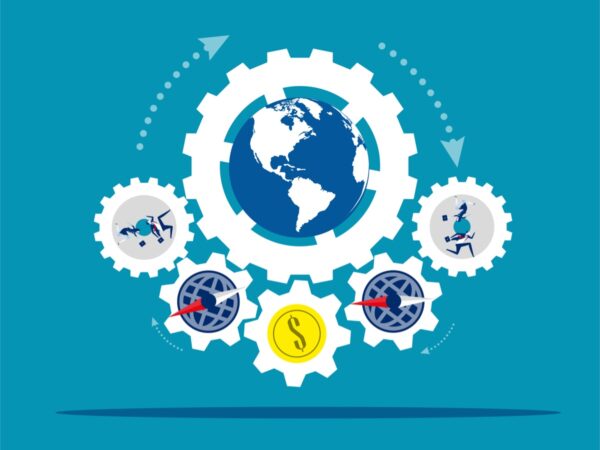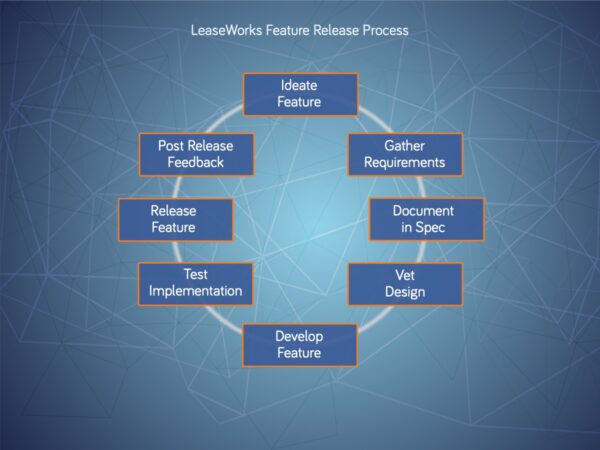Why Regular Releases Improve Customer Satisfaction
When you buy a software product, you typically think about whether or not its feature set can address your present needs. But it’s even more important that its upcoming capabilities support your needs into the future. The last thing you want is to adopt a product that is core to your operations that doesn’t evolve with you.
That’s why LeaseWorks maintains a quarterly release schedule.
Structuring around regular release cycles forces us to build a clean, modular software architecture. And it makes us keep our foot on the accelerator. It’s just human nature to ease up when your deadline is further into the future. Most exciting to us, it provides opportunities to delight our customers.
We can address bugs quickly
No software engineer likes to think there are mistakes in their code, but the reality is that it happens. Larger bugs are, of course, corrected immediately with patches. And with a quick release cadence, we can quickly get to the cosmetic issues as well.


About the Author
Roman Madebeikin is a product manager for the LeaseWorks Aeris Asset product with an aviation technical and continuing airworthiness background. He focuses on the technical and contracts asset management aspects of the tool. He can be reached at roman@lease-works.com.
Adapt rapidly to changing market conditions
Conditions in our professional and personal lives have never changed so suddenly as they did in 2020. The entire world had to pivot very quickly. And in our industry this meant, for one thing, more rent deferral or restructuring requests from airlines to lessors. To support this sudden influx, LeaseWorks was able to deliver a structured deal process in March 2020 to surface key information around such requests, speed up approvals, and record decisions. This couldn’t have happened on a yearly or longer release schedule.


Accommodate customer-specific feature requests while identifying common threads
As we work with you to tailor your instance of LeaseWorks to the needs of your team, we continuously come across new ideas for tools and functionality. These come as direct requests from you, and also through our customer success managers who see where you might have hit a roadblock in your process. During these interactions, our product managers see common threads that run across those requests, and these themes lead to general product features. But even when they are specific bits of functionality for a single customer, we can deliver them quickly because there’s always a release just around the corner.
Stay current with integrated software revisions
Like most products today, LeaseWorks isn’t a siloed piece of software. It’s just part of your technology stack, and it needs to play well with others. Being built on top of the world’s leading cloud platform (force.com from Salesforce), this is especially true for LeaseWorks. When Salesforce makes an update, we can usually adapt to it before their change even goes live, avoiding any bumps in the road for our customers. And when related integrations change, we can quickly adapt to those too. When a partner adds new features, we can pass them through to you quickly, and even build functionality on top to give you even more power.


Fail faster
Let’s face it. Nobody is right all the time, and LeaseWorks is no exception. When we do not get a feature just right, we reach out for customer feedback to guide us forward. And with quarterly releases, we’re just a few months away from making that new tool everything you need and everything we had hoped it could be.
A look inside the LeaseWorks-specific release process
We’d like to share our process with you! We hope this transparency will make us even easier to work with and also confirm to you our commitment to steady, relevant product expansion and improvement.
The core functionality of LeaseWorks is built upon years of collective experience the team has in working with and for lessors and airlines. Our product team hails from both sides of the aviation leasing equation. This means that they’re intimately familiar with the work you need to accomplish and the tasks you need to get done every day.
Their experience helps with future features too, but there’s an even more important factor… you.
As we work with you, our CSMs, product managers, and even developers keep their eyes and ears open. We take note of what you tell us about your pain points, and we pay attention as you use the LeaseWorks system. We see where the interface might be leaving you confused. We notice when you go outside of LeaseWorks to leverage additional tools and resources. And we try to create new modules to help you automate the process end to end.
We capture all these ideas in an Asana, each one tagged with customer names, product modules and functionality zones. Once per quarter, the product team comes together to evaluate our list of feature requests and create a prioritized list for inclusion in the next release.
A feature idea from six months ago might get bumped in favor of a request you made just yesterday. We strike a balance between features that have broad appeal across the industry and filling the specific needs of our existing customer base.
The product managers then create product specifications that outline the functionality, UI, behavior, and user experience of each included feature. Detailed specs ensure we’ve thought the concept through and structured these new tools in the best possible way.
After these specs are refined through a cooperation among product management, engineering and LeaseWorks management, they’re sent out to our team of advisors for their input. And, whenever possible, we discuss them with LeaseWorks customers as well to get their insight and unique view. This highly collaborative approach allows us to incorporate the most comprehensive view of the market need. Then, our developers get to work!
Along the way our devops team is planning for a seamless rollout, and our product managers peek in from time to time to make sure everything is coming out exactly the way we want it. When development is complete, our quality assurance agents test all features thoroughly before they’re deployed. Finally, our post-deployment process kicks in to catch any unforeseen implementation issues.

The LeaseWorks commitment to excellence
So, there you have it. Those are the highlights of how our feature development process works, and why we believe it will ensure that LeaseWorks is a valuable and integral part of your asset management process for years to come!

About the Author
Roman Madebeikin is a product manager for the LeaseWorks Aeris Asset product with an aviation technical and continuing airworthiness background. He focuses on the technical and contracts asset management aspects of the tool. He can be reached at roman@lease-works.com.